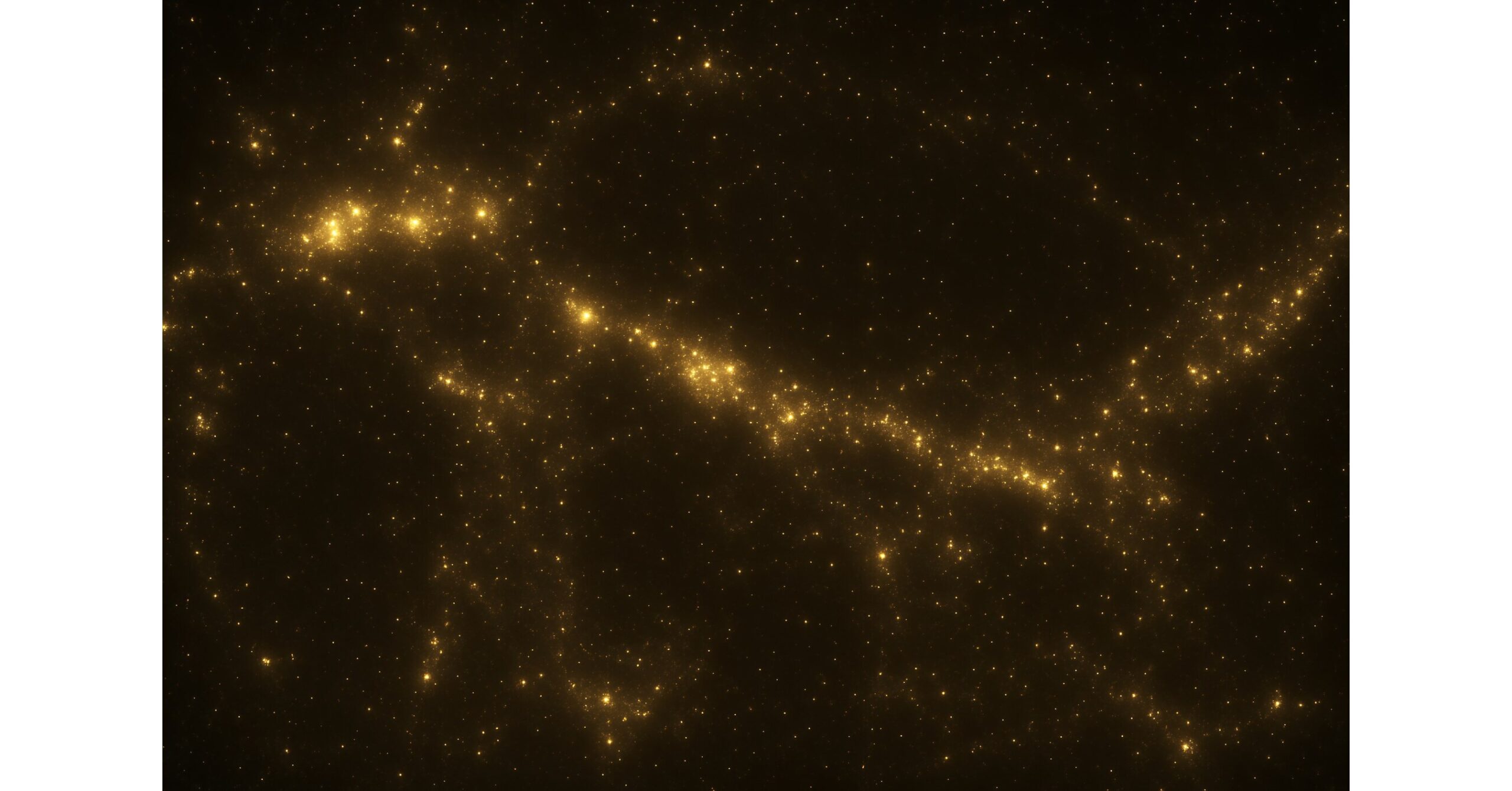A new study finds that galaxy clusters — cosmic cities packed with thousands of galaxies — trace invisible highways of dark matter stretching up to a billion light years across the universe. Even more remarkable, the clusters point the way to their neighbors.
FLAGSTAFF, Ariz., July 7, 2025 /PRNewswire/ — In a groundbreaking study of 1.58 million galaxy clusters, an international team of astronomers led by Dr. Michael West of Lowell Observatory mapped how the universe’s largest structures are arranged. They found that most clusters are elongated, like grains of rice. But unlike rice scattered at random, these clusters tend to align with one another, their elongated shapes pointing toward their neighbors like arrows tracing hidden highways across the cosmos. The team’s findings were published today in The Astrophysical Journal Letters.
The glowing lights of galaxies and galaxy clusters illuminate invisible dark matter highways in this region of the universe, viewed in the direction of the constellations Perseus and Pisces. Each dot is an entire galaxy, part of a colossal structure stretching across millions of light-years. Credit: Michael West.
“It’s like discovering that New York, Madrid, Rome, and Beijing were all built facing the same direction, perfectly aligned despite being thousands of miles apart,” said lead author Dr. Michael J. West of Lowell Observatory.
Astronomers have seen neighboring galaxy clusters align before, but never across such vast distances. This new study shows that clusters, like cities, are shaped by their surroundings. The biggest clusters develop where multiple dark matter highways intersect. Dark matter — the mysterious, invisible substance that makes up most of the universe’s mass — appears to determine cluster shapes and locations.
By examining the most distant clusters, the astronomers peered billions of years into the past and found that neighboring clusters were already aligned when the universe was still young — less than half its current age.
“This gives us a rare glimpse into how the universe grew up,” said co-author Dr. Maret Einasto of Tartu Observatory in Estonia. “It shows that the foundation of the universe’s largest structures was laid early, and galaxies have been following those paths ever since.”
To test their findings, the team turned to advanced computer simulations of the universe’s evolution. These simulations helped the scientists explore whether cluster alignments like those observed emerge naturally from known physics. They used the Last Journey simulation, developed by researchers at Argonne National Laboratory. This simulation tracks the motion of over a trillion particles as gravity shapes a virtual universe. The simulation revealed the same alignment patterns, supporting the idea that galaxy clusters form as matter flows along the universe’s dark matter highways.
“This is a cosmic traffic report,” said co-author Dr. Roberto De Propris of the Botswana International University of Science & Technology. “The cluster alignments show us which way galaxies have been flowing for billions of years.”
Other members of the team include Z.L. Wen and J.L. Han of the Chinese Academy of Sciences, whose comprehensive catalog of galaxy clusters made this research possible.
The full published paper can be found here: https://iopscience.iop.org/article/10.3847/2041-8213/ade66d
About Lowell Observatory
Lowell Observatory is a private, nonprofit 501(c)(3) research institution, founded in 1894 by Percival Lowell atop Mars Hill in Flagstaff, Arizona. The Observatory has been the site of many important discoveries, including the first detection of large recessional velocities (redshift) of galaxies by Vesto Slipher in 1912-1914 (a result that led ultimately to the realization that the universe is expanding), and the discovery of Pluto by Clyde Tombaugh in 1930.
Today, the Observatory’s 14 tenured astronomers use ground-based telescopes around the world, telescopes in space, and NASA planetary spacecraft to conduct research in diverse areas of astronomy and planetary science. Lowell Observatory currently operates multiple research instruments at its Anderson Mesa station, east of Flagstaff, and the 4.3-meter Lowell Discovery Telescope near Happy Jack, Arizona. Prior to the pandemic, the observatory also welcomed more than 100,000 guests per year to its Mars Hill campus in Flagstaff, Arizona, for a variety of educational experiences, including historical tours, science presentations, and telescope viewing.
SOURCE Lowell Observatory
